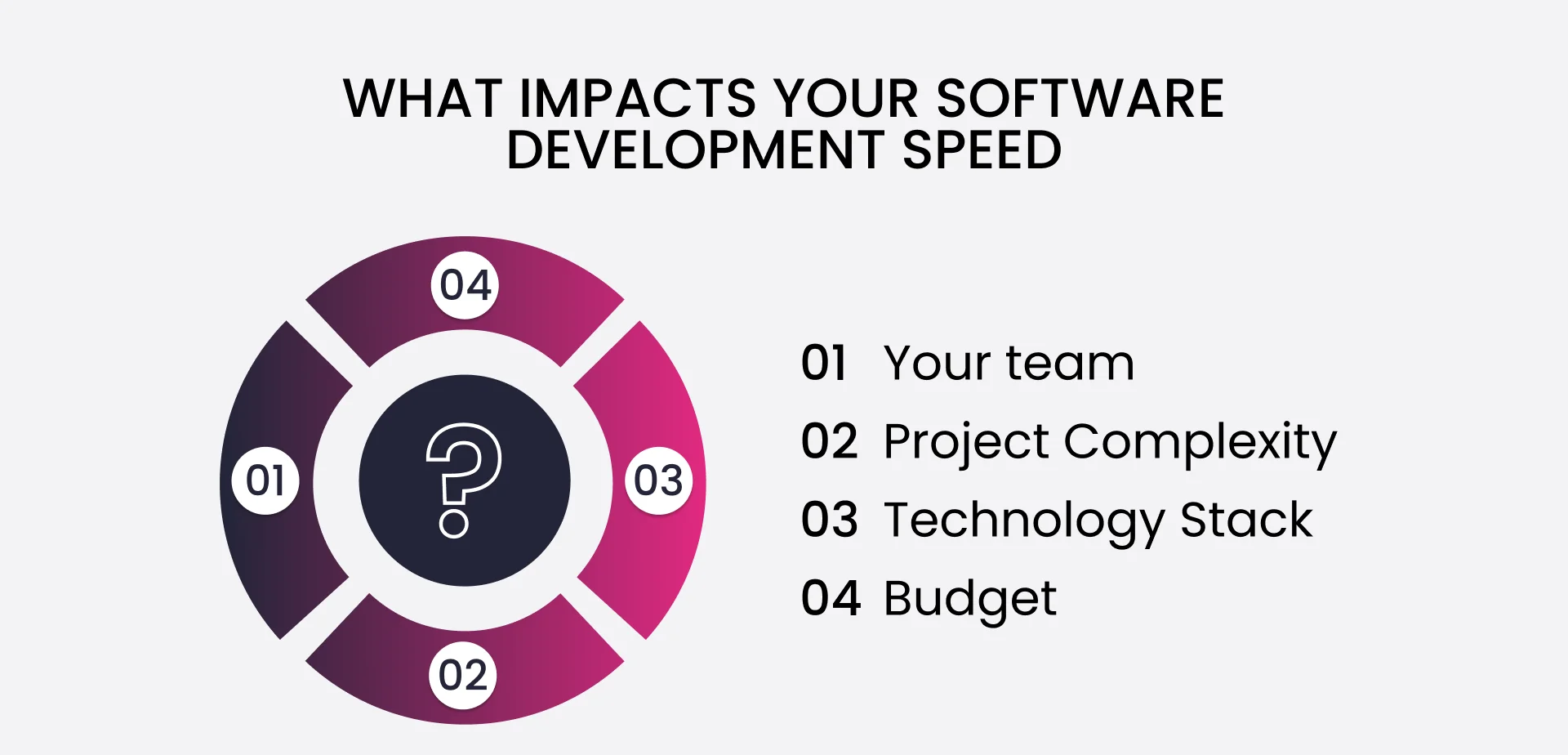Table of Content
- What impacts software development speed
- How to find the balance between speed and quality
- How to make your development team work faster
- Why more developers doesn’t mean faster development
- Strategies to speed up your software development process
Speed up your development process
Book a callWhile having an efficient and high-quality software launch is crucial, you probably don’t have the luxury of spending a lot of time constantly hiring developers that underdeliver or disappear. You want to test your idea on the market as soon as possible without risking competitors getting ahead of you or losing investors trust. At first, the most intuitive thing you feel like doing is adding more developers or using some tricky technologies that may look promising but will not work. By the end of this article, you’ll discover how to speed up a software development process, all about software development speed vs. quality, and how to train your team to have a balance between those two.
What impacts your software development speed
Now, more than ever, there are several misconceptions or false beliefs when it comes to speeding up the software development process. Some CEO’s of software product companies may apply strategies like pushing their team to work longer, thinking it will lead to faster delivery, when in reality it causes burnout and fatigue, leading to more mistakes. Some reduce the testing and quality assurance thinking they will save money and eventually have an earlier release, which leads to bugs, bad customer experience, and emergency fixes. And most commonly, they try adding more developers, thinking that increasing the size of their team will lead to faster results. The software development process is not a construction site where more workers means faster results, but we’re going to talk about this in more detail in just a few moments.
Discover about software development delays and why projects end up late
Here are some factors that will positively impact your software development process speed and quality:
-
Your team
It goes without saying that a more experienced team of developers with good communication with each other will always outperform a less capable team when it comes to speed and making fewer mistakes within the process. The right software development partner (team) = on-time launch of a quality product.
Actionable step: Consider having training sessions and different workshops to upskill your team of developers and teach them how to speed up software development and have higher quality work.
-
Project Complexity
Having a larger project with more numerous and complex features, integrations, and intricacies will intuitively take more time. Besides these factors, there are the back-end algorithms, data, code complexity, and many other things that add up to the total time of the process.
Actionable step: To make a complex project even slightly easier, break down the project into smaller and more manageable tasks. Your team will find it easier to focus on structured individual components and will reduce the risks of mistakes and confusion.
-
Technology Stack
Some of the frameworks and tools you use may have faster development cycles and others slower ones. The same goes with debugging or testing tools, which can speed or slow the development process depending on how advanced they are.
Actionable step: Ensure your tools and technology stack still meets your project needs, and try adding more useful tools to help you with testing, building, and even deploying the software.
-
Budget
A lower and more strict budget will limit the access to certain tools and the quality of those tools, leading to a slower process.
Actionable step: We suggest allocating a budget that will only go towards extra developers, newer and better tools, or external consultants to help you at different stages of your process.

Finding the sweet spot between speeding up and keeping quality high
Software development speed vs. quality has been the most asked question lately. Take fast food and fine dining restaurants as an example. A fast-food restaurant goal is to satisfy your needs as fast as possible without concentrating on the quality of the food or the experience itself. A fine dining restaurant may take longer to cook your meal, but they clearly focus on offering you the best experience, either in terms of the plating, food quality, or taste.
Now, you may ask, which approach should I apply to my software development process—the fast food route or the fine dining one?
Neither. The key lies in the balance between those two. You may be in a rush to meet deadlines, have faster time-to-market, or need to present it to your investors as soon as possible, so taking the fine dining route may not be the most optimal. On the other side, you want your software to be good and have a large and happy user base, so a fast-food approach may quickly end your business.
Read further to see how to speed up software development and how we position the projects we’re working on in that sweet spot between speed and quality.
Looking for a tech partner for your startup?
Make your development team work faster without sacrificing quality
As mentioned in the last section, there is no straight-up answer between software development speed vs. quality; it’s all about maintaining the perfect balance, which is crucial for getting the benefits of an early release while still having high-quality and reliable software.
But how to actually improve the speed of your development team while ensuring that they maintain a high level of quality over time?
We’re going to take them one by one. Let’s first talk about improving the speed of your development team:
-
Automate Repetitive Tasks
Some routine tasks may not require the human factor as much, and the repetitiveness can cause errors when handled by someone. Look for automating processes like testing to reduce manual effort and save significant time.
-
Improve Communication
Better communication and collaboration can help avoid any misunderstandings between your team members. Use any communication channel tools for smoother and faster communication and project management tools so everyone knows what they need to do.
-
Prioritize Features
To avoid wasting time on tasks that are not yet necessary, use a prioritization framework to determine what features or tasks your team should focus on first that will deliver immediate value to your users.
This feature prioritization is also called an MVP, which is a Minimal Viable Product that only contains the most essential features to allow an earlier release and test the product. To discover more about what an MVP is and if you need one, check our MVP software development services.
Let’s talk about your project? Feel free to ask any additional questions you might have. Our experts will be glad to assist you.

-
Having a Strong Code Review Process
Constantly have someone review and catch any unexpected issues as early as possible, improving the code quality over time. You can do this by establishing a code review process where, before deploying any piece of code, one or more developers carefully test and review it.
-
Invest in Training
Having a more skilled and prepared team will ensure faster and higher-quality work. Occasionally schedule training sessions for your team on the latest techniques, best practices, and tools.
-
Ingrain Quality in the Team’s Culture
Encourage developers to follow best practices like Test-Driven Development and take ownership of their work. Encourage them to take on the responsibility of having high-quality work without settling for less.

Why more developers doesn’t mean faster development
Increasing the size of your development team may seem like a quick fix that will increase the speed of your software development team. After all, doesn’t having a larger labor force mean better and faster results? Not at all. Some issues and roadblocks will result from adding more developers to your team, which can delay your software launch. Here are some of them:
- Communication overload: Having more team members means a higher need for coordination and communication within the team, so more meetings and emails are needed, and there is a higher chance of misunderstandings and potential problems coming up.
- Ramp-uo Challenges: Onboarding new developers means having existing team members focus on mentoring them and documenting processes while putting the actual relevant tasks lower on the priority list.
- Project Complexity: Most of the modern software projects have complex ecosystems that are harder or impossible to task share. Adding more people to such complex tasks often lead to confusion and double effort rather than rational efficiency.

If you can’t add new team members to help you with your current workload and challenges, you may think about how to speed up software development team with your current team, right? Here are 3 strategies that will help you increase efficiency and optimize the development process within your team…
Read the post by our CEO on Linkedin: Why more developers do not always mean better or faster results.
3 effective strategies to speed up your software development process
After developing tons of software for different companies, we found the 3 most effective and optimal strategies on how to speed up the software development process while still keeping quality high and having a highly productive and efficient team of developers.
-
Next-level Agile
This is similar to the traditional Agile approach but takes it a step further by focusing a lot more on improving the development process. When there is a lack of communication and a lot of intricacies, Agile helps your team clearly identify all the roadblocks and focus on what actually adds value to the product. You can use tools like value stream analysis to automate and optimize tasks and testing, which will exponentially speed up the process.
-
Conceptual Integrity
This is all about proper planning and a clear vision. Always keep the initial big picture in mind when structuring a system. It’s crucial to have a master architect or a close team to help ensure that all decisions match the user’s needs. Having fewer but well-planned features makes the system easier to use and understand and keeps everything aligned with the initial vision.
-
Surgical Groups
Assign your development team with specific roles, each having its own responsibilities and tasks. The main thing is to appoint a key developer to handle the most complex and critical aspects of the systems, while the rest provide assistance and help with less important components. This way, each team member knows what they have to do, and they can focus on doing it well, helping the whole process and team work faster and more efficiently.

Quick Summary
Deadlines and timeframes are indeed frustrating, especially when unfortunate events that delay your development time happen. Maybe you have to present your software to your investors as soon as possible or to have fast time-to-market and get ahead of competitors. And all of this becomes way harder when unwanted events occur, such as disappearing or underdelivering developers.
To summarize the “how to speed up software development” question, just follow the tips and strategies we talked about, and always keep a balance between rushing things and spending enough time to make them good.
We understand that all of this may sound too overwhelming, or you simply don’t have the time or energy to take this into your own hands…
So if you are looking for a trusted software development company to take this off of your busy to-do list, get a free project estimation.
Questions? Answers!
How can I prioritize speed without sacrificing quality?
There’s no winner between software development speed vs. quality; to prioritize speed without sacrificing quality, you should only focus on developing and delivering high-quality features first. This means using an Agile approach, using tools that will automate most of your routine processes (e.g., CI/CD pipelines, testing), and constantly having someone review the code before it is merged. Simply put, by keeping an eye out for issues, addressing feedback promptly, and keeping your tech debt in check, you can increase development speed while still keeping quality standards high.
How long does software development usually take?
It depends on some factors such as project complexity, team size, requirements, and the technology needed. It can take about 2 to 3 months for a small project and up to 9+ months for a larger and more complex project. If these seem too long, read the whole article to discover how to speed up the software development process.
How does agile development help balance speed and quality in software development?
What Agile development basically does is break work into smaller and more manageable tasks. This makes it easier for your team to consistently review, give feedback, and make any necessary improvements. It ensures faster development and also helps maintain high quality with regular testing, reviews, and rapid adjustments.


